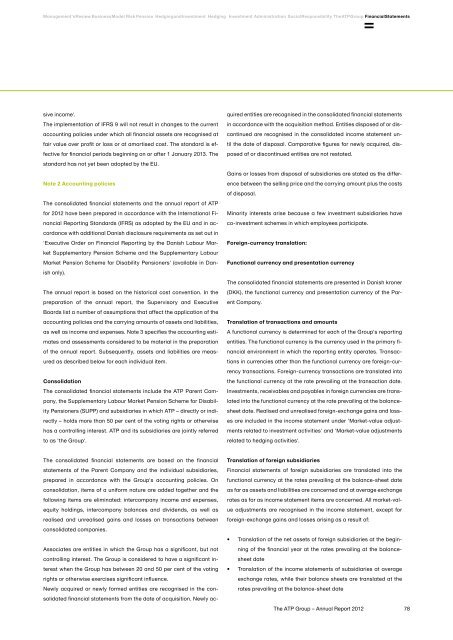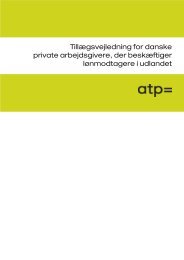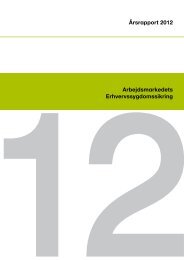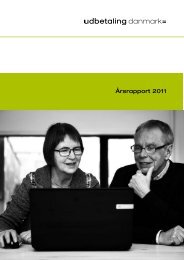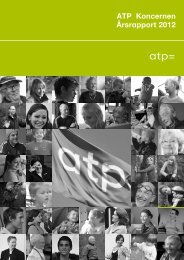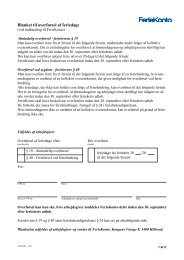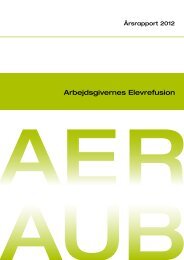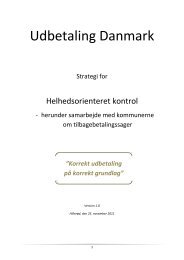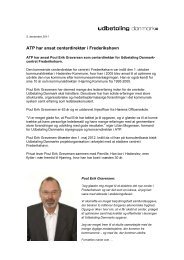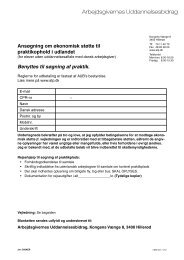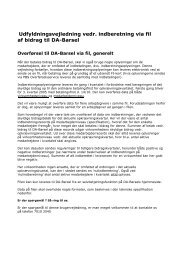The ATP Group Annual Report 2012
The ATP Group Annual Report 2012
The ATP Group Annual Report 2012
Create successful ePaper yourself
Turn your PDF publications into a flip-book with our unique Google optimized e-Paper software.
Management's Review Business Model Risk Pension Hedging and Investment Hedging Investment A d m i n i s t r a t i o n S o c i a l R e s p o n s i b i l i t y T h e AT P G r o u p Financial Statementssive income'.<strong>The</strong> implementation of IFRS 9 will not result in changes to the currentaccounting policies under which all financial assets are recognised atfair value over profit or loss or at amortised cost. <strong>The</strong> standard is effectivefor financial periods beginning on or after 1 January 2013. <strong>The</strong>standard has not yet been adopted by the EU.Note 2 Accounting policies<strong>The</strong> consolidated financial statements and the annual report of <strong>ATP</strong>for <strong>2012</strong> have been prepared in accordance with the International Financial<strong>Report</strong>ing Standards (IFRS) as adopted by the EU and in accordancewith additional Danish disclosure requirements as set out in'Executive Order on Financial <strong>Report</strong>ing by the Danish Labour MarketSupplementary Pension Scheme and the Supplementary LabourMarket Pension Scheme for Disability Pensioners' (available in Danishonly).<strong>The</strong> annual report is based on the historical cost convention. In thepreparation of the annual report, the Supervisory and ExecutiveBoards list a number of assumptions that affect the application of theaccounting policies and the carrying amounts of assets and liabilities,as well as income and expenses. Note 3 specifies the accounting estimatesand assessments considered to be material in the preparationof the annual report. Subsequently, assets and liabilities are measuredas described below for each individual item.Consolidation<strong>The</strong> consolidated financial statements include the <strong>ATP</strong> Parent Company,the Supplementary Labour Market Pension Scheme for DisabilityPensioners (SUPP) and subsidiaries in which <strong>ATP</strong> – directly or indirectly– holds more than 50 per cent of the voting rights or otherwisehas a controlling interest. <strong>ATP</strong> and its subsidiaries are jointly referredto as 'the <strong>Group</strong>'.<strong>The</strong> consolidated financial statements are based on the financialstatements of the Parent Company and the individual subsidiaries,prepared in accordance with the <strong>Group</strong>'s accounting policies. Onconsolidation, items of a uniform nature are added together and thefollowing items are eliminated: intercompany income and expenses,equity holdings, intercompany balances and dividends, as well asrealised and unrealised gains and losses on transactions betweenconsolidated companies.Associates are entities in which the <strong>Group</strong> has a significant, but notcontrolling interest. <strong>The</strong> <strong>Group</strong> is considered to have a significant interestwhen the <strong>Group</strong> has between 20 and 50 per cent of the votingrights or otherwise exercises significant influence.Newly acquired or newly formed entities are recognised in the consolidatedfinancial statements from the date of acquisition. Newly acquiredentities are recognised in the consolidated financial statementsin accordance with the acquisition method. Entities disposed of or discontinuedare recognised in the consolidated income statement untilthe date of disposal. Comparative figures for newly acquired, disposedof or discontinued entities are not restated.Gains or losses from disposal of subsidiaries are stated as the differencebetween the selling price and the carrying amount plus the costsof disposal.Minority interests arise because a few investment subsidiaries haveco-investment schemes in which employees participate.Foreign-currency translation:Functional currency and presentation currency<strong>The</strong> consolidated financial statements are presented in Danish kroner(DKK), the functional currency and presentation currency of the ParentCompany.Translation of transactions and amountsA functional currency is determined for each of the <strong>Group</strong>'s reportingentities. <strong>The</strong> functional currency is the currency used in the primary financialenvironment in which the reporting entity operates. Transactionsin currencies other than the functional currency are foreign-currencytransactions. Foreign-currency transactions are translated intothe functional currency at the rate prevailing at the transaction date.Investments, receivables and payables in foreign currencies are translatedinto the functional currency at the rate prevailing at the balancesheetdate. Realised and unrealised foreign-exchange gains and lossesare included in the income statement under 'Market-value adjustmentsrelated to investment activities' and 'Market-value adjustmentsrelated to hedging activities'.Translation of foreign subsidiariesFinancial statements of foreign subsidiaries are translated into thefunctional currency at the rates prevailing at the balance-sheet dateas far as assets and liabilities are concerned and at average exchangerates as far as income statement items are concerned. All market-valueadjustments are recognised in the income statement, except forforeign-exchange gains and losses arising as a result of:• Translation of the net assets of foreign subsidiaries at the beginningof the financial year at the rates prevailing at the balancesheetdate• Translation of the income statements of subsidiaries at averageexchange rates, while their balance sheets are translated at therates prevailing at the balance-sheet date<strong>The</strong> <strong>ATP</strong> <strong>Group</strong> – <strong>Annual</strong> <strong>Report</strong> <strong>2012</strong>78


